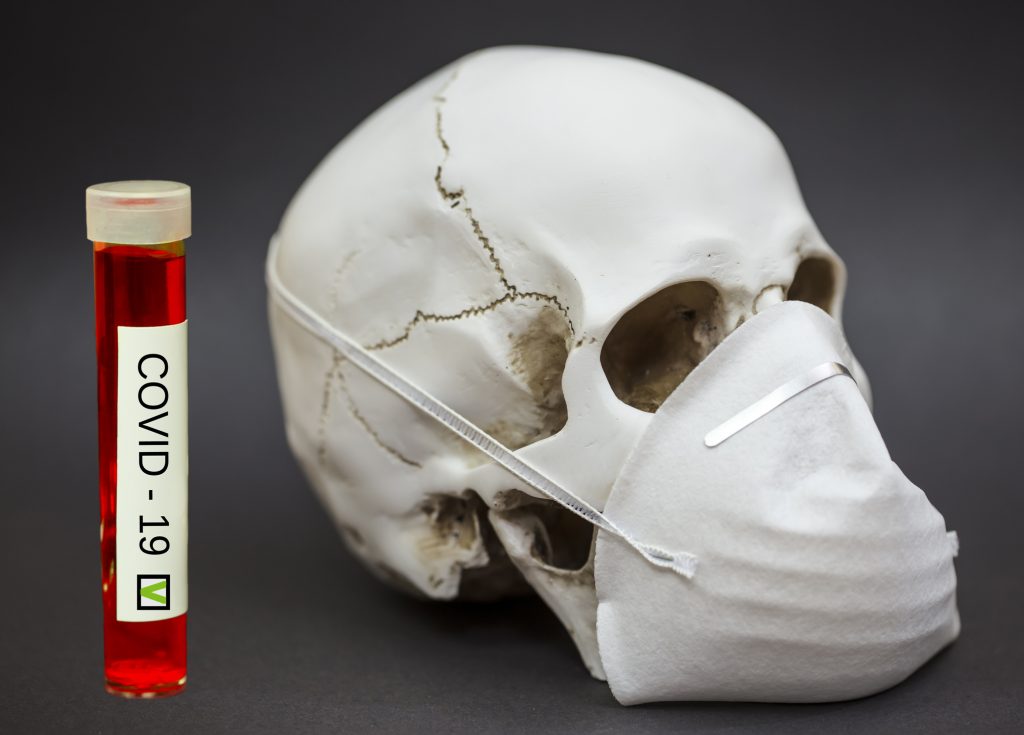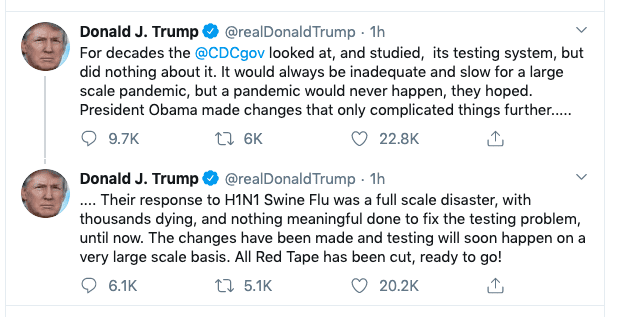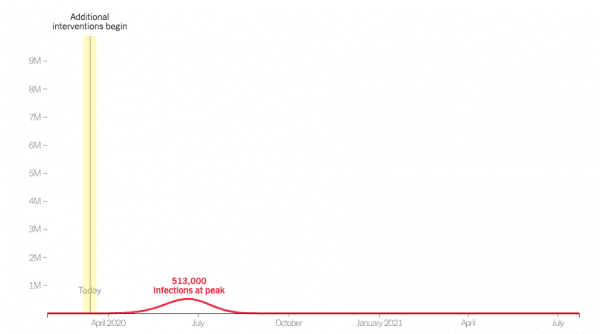The Coming Coronavirus Storm

You better sit down for this one. The New York Times got its hands on a presentation given at a CDC conference in February that gathered the agency’s senior officials, and top epidemiological experts, together at a meeting to game out how bad the virus outbreak could be in the US. Here’s what they discussed. Excerpts:
The C.D.C.’s scenarios were depicted in terms of percentages of the population. Translated into absolute numbers by independent experts using simple models of how viruses spread, the worst-case figures would be staggering if no actions were taken to slow transmission.
Between 160 million and 214 million people in the U.S. could be infected over the course of the epidemic, according to one projection. That could last months or even over a year, with infections concentrated in shorter periods, staggered across time in different communities, experts said. As many as 200,000 to 1.7 million people could die.
And, the calculations based on the C.D.C.’s scenarios suggested, 2.4 million to 21 million people in the U.S. could require hospitalization, potentially crushing the nation’s medical system, which has only about 925,000 staffed hospital beds. Fewer than a tenth of those are for people who are critically ill.
More:
Even severe flu seasons stress the nation’s hospitals to the point of setting up tents in parking lots and keeping people for days in emergency rooms. Coronavirus is likely to cause five to 10 times that burden of disease, said Dr. James Lawler, an infectious diseases specialist and public health expert at the University of Nebraska Medical Center. Hospitals “need to start working now,” he said, “to get prepared to take care of a heck of a lot of people.”
Dr. Lawler recently presented his own “best guess” projections to American hospital and health system executives at a private webinar convened by the American Hospital Association. He estimated that some 96 million people in the U.S. would be infected. Five out of every hundred would need hospitalization, which would mean close to five million hospital admissions, nearly two million of those patients requiring intensive care and about half of those needing the support of ventilators.
Dr. Lawler’s calculations suggested 480,000 deaths, which he said was conservative. By contrast, about 20,000 to 50,000 people have died from flu-related illnesses this season, according to the C.D.C. Unlike with seasonal influenza, the entire population is thought to be susceptible to the new coronavirus.
The good news — if a story like this has any good news — is that we can save a lot of lives if we implement aggressive social distancing and other public health measures at once. But we can’t wait till it gets bad to do so:
“All U.S. cities and states have the natural experiment of the cities that have preceded us, namely the superb response of Singapore and Hong Kong,” said Dr. Michael Callahan, an infectious disease specialist at Harvard. Those countries implemented school closures, eliminated mass gatherings, required work from home, and rigorously decontaminated their public transportation and infrastructure. They also conducted widespread testing.
They were able to “reduce an explosive epidemic to a steady state one,” Dr. Callahan said.
As in the case of an approaching hurricane, Dr. Mecher said, “You’ve got to take potentially very disruptive actions when the sun is shining and the breeze is mild.”
So, wait: The top CDC officials met last month with the country’s best academic experts to put their heads together and figure out what we’re dealing with here, and President Trump was still doing his Mayor from “Jaws” shtick? From CNN on March 1:
The visit [to the CDC] comes as Trump has fumed in recent days at Dr. Nancy Messonnier, the director of the CDC’s National Center for Immunization and Respiratory Diseases, who recently said, “It’s not so much of a question of if this will happen anymore but rather more of a question of exactly when this will happen.”
Trump thought officials like Messonnier were causing unnecessary alarm.
The Times story doesn’t say if Dr. Messonnier was in the room for the presentation, but it would be very strange if, as one of the CDC’s senior officials, she had not been. We know that she met with the president, who publicly contradicted her at a February 27 press conference, saying that she was wrong to say the virus’s spread is “inevitable.” You will recall that at that time, Limbaugh and others in Trumpworld were trying to destroy Dr. Messonnier’s credibility by pointing out that she’s the sister of Rod Rosenstein. The Conspirator-in-Chief tweeted at the time:
Low Ratings Fake News MSDNC (Comcast) & @CNN are doing everything possible to make the Caronavirus look as bad as possible, including panicking markets, if possible. Likewise their incompetent Do Nothing Democrat comrades are all talk, no action. USA in great shape! @CDCgov…..
— Donald J. Trump (@realDonaldTrump) February 26, 2020
So you have to wonder: did Dr. Messonnier or anybody in the CDC tell the president what the agency’s expert panel was projecting? How could they not have done? Well, today’s Times story says:
The C.D.C. declined interview requests about the modeling effort and referred a request for comment to the White House Coronavirus Task Force. Devin O’Malley, a spokesman for the task force, said that senior health officials had not presented the findings to the group.
I do not believe a word Devin O’Malley says. Well, let me qualify that. I presume that he’s telling the truth as he knows it, and it may be technically true that the task force did not get a briefing by the CDC on this particular conference. But it beggars belief to think that the CDC’s briefings to the White House on what the country faced did not include information from this earlier panel. This administration has no credibility at all. It’s gone. Trump had to have known last month how bad this was going to get, but he lied to the nation about it (the charitable view is that this was because he was lying to himself), and he and his henchmen tried to destroy the credibility of a medical truth-teller.
Notice too that the administration is forcing public health experts to defer comment to the political operation in the White House. And this morning, Trump is in full blame-shifting mode:

Some leader, eh? The thing is, I believe it might well be the case that the CDC’s internal bureaucratic procedures screwed this up. But the fact of the matter is, Trump has been president for three years, and did nothing to fix the problem. What’s more, given that his former National Security advisor John Bolton dismissed the NatSec aides working on global pandemic response, we know for a fact that public health readiness was not a priority for him. His defensive griping rings very hollow.
Yesterday I phoned my mom to check on her. She’s an elderly woman with lung problems, and therefore at prime risk. She had been inside all day watching Fox News, her only source of news. Know what her headline for me was? About how terrible the Democrats are, politicizing this thing to hurt the president. Of course I have no way of knowing what Fox is reporting — I don’t have cable — and to what extent she is watching through the eyes of a Trump voter, with all the confirmation bias that entails. But it concerned me that this is how she sees this issue, based on watching Fox all day long.
With that in mind, look:
Fox is the most watched channel by the highest risk demographic group. They have a special obligation to provide responsible risk information. https://t.co/XQuGWJV9A3
— Jeremy FLATTEN THE CURVE Konyndyk (@JeremyKonyndyk) March 13, 2020
When this is over, there is going to be a terrible, terrible reckoning.
Meanwhile, take the information in the Times report about how serious this thing could get, and let it guide your personal decisions about going out in public, and so forth. All of us have a role to play in protecting our families and communities, and indeed the country. Decisions that you and I make regarding our personal conduct could easily make the difference between life and death for a lot of Americans. Yesterday an Italian doctor was quoted as saying that a child with no symptoms, but a carrier of the disease, can go visit his grandparents “and basically kill them.”
This is how we have to start thinking about the crisis, and changing our behavior.
Here’s an interesting tool from Stuart Thompson and Nicholas Kristof, showing how much better or worse the epidemic’s spread can be, based on whether or not we in the population adopt behavioral measures that limit it. Take a look at it, and play with it. It really does bring home how much good we can all do if we act now, and stick to our plans. By the way, the NYT has made all its coronavirus coverage free to non-subscribers. If we do no meaningful interventions, this is how it’s going to look, on current track:

If, however, we start implementing aggressive measures today, this is how it’s going to look:

These are the Worst Case and Best Case scenarios. What we actually do is going to be somewhere in between. The point is, we have it in our power to flatten that curve! Flattening the curve, though, means that we all have to understand that a hurricane is upon us, and that if we’re going to survive it with as few deaths as possible, we all have a part to play. Nobody from the government is going to come in to save us. This is on us, especially if we are a leader of an institution.